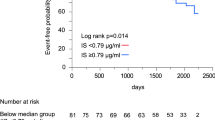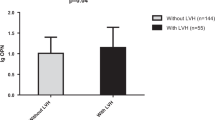Abstract
Soluble ST2 is a biomarker of cardiomyocyte stretch that is useful in the diagnosis and prognosis of coronary artery disease. Its role in the field of hypertension and hypertensive heart failure (HHF) has not yet been well investigated. We studied the effect of left ventricular remodelling on the concentration of soluble ST2 in a cohort of 210 subjects with hypertension (HT). Left ventricular hypertrophy (LVH) was considered present when echocardiographic left ventricular mass indexed for height in metres (m) was greater than 46.2 g m−1 2.7 in women and 49.2 g m−1 2.7 in men. Subjects were subdivided into three groups: those without LVH (HT, n=83); those with LVH (hypertension with left ventricular hypertrophy (HTLVH), n=50) and those with HHF, n=77). Plasma ST2 and NT-pro BNP were measured using electrochemiluminescence type immunoassay. Subjects with HHF had higher plasma ST2 concentrations compared to HTLVH (134.7±57.3 ng ml−1 versus 23.0±8.3 ng ml−1, P<0.001) and those with HT (134.7±57.3 ng ml−1 versus 14.5±4.9 ng ml−1, P<0.0001). NT-pro BNP levels were similar when HTLVH was compared with HT (P=0.68), but subjects with HHF had significantly higher NT-pro BNP compared to HTLVH (P<0.0002). Soluble ST2 had strong correlation with clinical and echocardiograhic parameters, and correlated well with NT-pro BNP (r=0.41, P<0.0001). Plasma ST2 is a useful biomarker in not only differentiating HHF from HT with or without LVH, but also distinguishes hypertensive LVH from HT without LVH.
This is a preview of subscription content, access via your institution
Access options
Subscribe to this journal
Receive 12 digital issues and online access to articles
$119.00 per year
only $9.92 per issue
Buy this article
- Purchase on Springer Link
- Instant access to full article PDF
Prices may be subject to local taxes which are calculated during checkout



Similar content being viewed by others
References
Townsend MJ, Fallon PG, Matthews DJ, Jolin HE . T1/ST2-deficient mice demonstrate the importance of T1/ST2 in developing primary T helper cell type 2 responses. J Exp Med 2000; 191: 1069–1076.
Weinberg EO, Shimpo M, De Keulenaer GW, MacGillivary C, Tominaga S, Solomon SD et al. Expression and regulation of ST2, and interleukin-1 receptor family member, in cardiomyocytes and myocardial infarction. Circulation 2002; 106: 2961–2962.
Weinberg EO, Shimpo M, Hurwitz S, Tominaga S, Rouleau JL, Lee RT . Identification of serum soluble ST2 receptor as a novel heart failure biomarker. Circulation 2003; 107: 721–726.
Sabatine MS, Morrow DA, Higgins LJ, MacGillivary C, Guo W, Bode C et al. Complementary roles for biomarkers of biomechanical strain ST2 and N-terminal prohormone B-type natriuretic peptide in patients with ST-elevation myocardial infarction. Circulation 2008; 117: 1936–1944.
Diez J . Serum soluble ST2 as a biochemical marker of acute heart failure: future areas of research. JACC 2008; 52 (18): 1466–1467.
Rehman S, Mueller T, Januzzi J . Characteristics of the novel interleukin family biomarker ST2 in patients with acute heart failure. J Am Coll Cardiol 2008; 52: 1458–1465.
Shah RV, Chen-Tournoux AA, Picard MH, van Kimmenade RRJ, Januzzi JL . Serum levels of the interleukin-1 receptor family member st2, cardiac structure and function, and long-term mortality in patients with acute dyspnoea. Circ Heart Fail 2009; 2: 311–319.
US Department of Health and Human Sciences. The seventh report of the joint national committee on prevention, evaluation and treatment of high blood pressure. NIH Publication 2004; 04: 5230.
Ojji D, Stewart S, Ajayi S, Mamven M, Sliwa K . A predominance of hypertensive heart failure in the Abuja Heart Study cohort of urban Nigerians: a prospective clinical registry of 1515 de novo cases. Eur J Heart Fail 2003; 15: 835–842.
Izzo JL, Gradman AH . Mechanisms and management of hypertensive heart disease: from left ventricular hypertrophy to heart failure. Med Clin N Am 2004; 88: 1257–1271.
Damasceno A, Mayosi BM, Sani M, Ogah OS, Mondo C, Ojji D et al. The causes, treatment and outcome of acute heart failure in 1006 Africans from 9 countries. Arc Intern Med 2012; 172 (18): 1386–1394.
Talwar S, Siebenhofer A, Williams B, Nq l . Influence of hypertension, left ventricular hypertrophy and left ventricular systolic dysfunction on plasma N terminal pro BNP. Heart 2000; 83: 278–282.
Swedberg K, Cleland J, Dargie H, Drexler H, Follath F, Komajda M et al. Guidelines for the diagnosis and treatment of chronic heart failure: executive summary (update 2005): the task force for the diagnosis and treatment of chronic heart failure of the European Society of Cardiology. Eur Heart J 2005; 26: 1115–1140.
Dieplinger B, Januzzi J, Steinmair M, Gabriel C, Poelz W, Haltmayer M et al. Analytical and clinical evaluation of a novel highisensitivity assay for measurement of soluble ST2 in human plasma-the Presage ST2 assay. Clin Chem Acta 2009; 409: 33–40.
Dieplinger B, Egger M, Poelz W, Haltmayer M, Mueller T . Long-term stability of soluble ST2 in frozen plasma samples. Clin Biochem 2010; 43: 1169–1170.
Mueller T, Dieplinger B, Gegenhuber A, Poelz W, Pacher R, Haltmayer M . Increased plasma concentrations of soluble ST2 are predictive for 1-year mortality in patients with acute destabilized heart failure. Clin Chem 2008; 54 (4): 752–756.
Prickett TC, Yandle TG, Nicholls MG, ESpiner EA, Richards AM . Identification of amino-terminal pro-C-type natriuretic peptide in human plasma. Biochem Biophys Res Commun 2001; 286 (3): 513–517.
Sahn DJ, DeMaria A, Kisslo J, Weyman A . Recommendations regarding quantitation in M-mode echocardiography: results of a survey of echocardiographic measurements. Circulation 1978; 58: 1072–1083.
Teichholz LE, Kreulen T, Herman MV, Gorlin R . Problems in echocardiographic volume determinations: echocardiographic-angiographic correlations in the presence of absence of asynergy. Am J Cardiol 1976; 37: 7–11.
Devereux RB, Alonso DB, Lutas EM, Gottlieb GJ, Campo E, Sachs I et al. Echocardiographic assessment of left ventricular hypertrophy: comparison to necropsy findings. Am J Cardiol 1986; 57: 450–458.
Palmieri V, Dahlof B, DeQuattro V, Sharpe N, Bella JN, de Simone G et al. Reliability of echocardiographic assessment of left ventricular structure and function: the PRESERVE study. Prospective Randomized Study Evaluating Regression of Ventricular Enlargement. J Am Coll Cardiol 1999; 34: 1625–1632.
Jurcut R, Giusca S, La Gerche A, Vasile S, Ginghina C, Voigt JU . The echocardiographic assessment of the right ventricle: what to do in 2010? Eur J Echocardiogr 2010; 11: 81–96.
Sanada S, Hakuno D, Higgins LJ, Schreiter ER, McKenzie AN, Lee RT . IL-33 and ST2 comprise a critical biomechanically induced and cardioprotective signaling system. J Clin Invest 2007; 117: 1538–1549.
Seki K, Sanada S, Kudinova AY, Steinhauser ML, Handa V, Gamon J et al. Interleukin-33 prevents apoptosis and improves survival after experimental myocardial infarction through ST2 signaling. Circ Heart Fail 2009; 2: 684–691.
Karaye KM, Sani MU . Factors associated with poor prognosis among patients admitted with heart failure in a Nigerian tertiary medical centre: a cross-sectional study. BMC Cardiovasc Disord 2008; 8: 16–18.
Daniels L, Clopton P, Iqbal N, Tran K, Maisel AS . Association of ST2 levels with cardiac structure and function and mortality in outpatients. Am Heart J 2010; 160 (4): 721–728.
Shah K, Kop W, Christenson R, Diercks DB, Henderson S, Hanson K et al. Prognostic utility of ST2 in patients with acute dyspnea and preserved left ventricular ejection fraction. Clin Chem 2011; 57: 874–882.
Fruhwald FM, Fahrleitner A, Watzinger N, Fruhwald S, Dobnig H, Shumacher M et al. Natriuretic peptides in patients with diastolic dysfunction due to idiopathic dilated cardiomyopathy. Eur Heart J 1999; 20: 1415–1423.
Redfield MM, Rodeheffer RJ, Jacobsen SJ, Mahoney DW, Bailey KR, Burnett JC Jr . Plasma brain natriuretic peptide concentration: impact of age and gender. J Am Coll Cardiol 2002; 40: 976–982.
Srisawasdi P, Vanavanan S, Charoenpanichkit C, Kroll MH . The effect of renal dysfunction on BNP, NT-proBNP and their ratio. Am J Clin Pathol 2010; 133: 14–23.
Milani RV, Drazner MH, Lavie CJ, Morin DP, Ventura HO . Progression from concentric left ventricular hypertrophy and normal ejection fraction to left ventricular dysfunction. Am J Cardiol 2011; 108: 992–996.
Acknowledgements
Our sincere appreciation goes to Mrs Sylvia Dennis for editing this manuscript and to all other members of staff Hatter Institute for Cardiovascular Research in Africa, Department of Medicine, Faculty of Health Sciences, University of Cape Town, South Africa. This work was partly funded by a grant from Pulmonary Vascular Research Institute, Medical Research Council South Africa and the University of Cape Town.
Author information
Authors and Affiliations
Corresponding author
Ethics declarations
Competing interests
The authors declare no conflict of interest.
Rights and permissions
About this article
Cite this article
Ojji, D., Opie, L., Lecour, S. et al. The effect of left ventricular remodelling on soluble ST2 in a cohort of hypertensive subjects. J Hum Hypertens 28, 432–437 (2014). https://doi.org/10.1038/jhh.2013.130
Received:
Revised:
Accepted:
Published:
Issue Date:
DOI: https://doi.org/10.1038/jhh.2013.130
Keywords
This article is cited by
-
Amylin deposition activates HIF1α and 6-phosphofructo-2-kinase/fructose-2, 6-biphosphatase 3 (PFKFB3) signaling in failing hearts of non-human primates
Communications Biology (2021)
-
Alterations in Cardiac Structure and Function in Hypertension
Current Hypertension Reports (2014)



